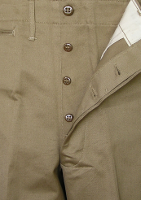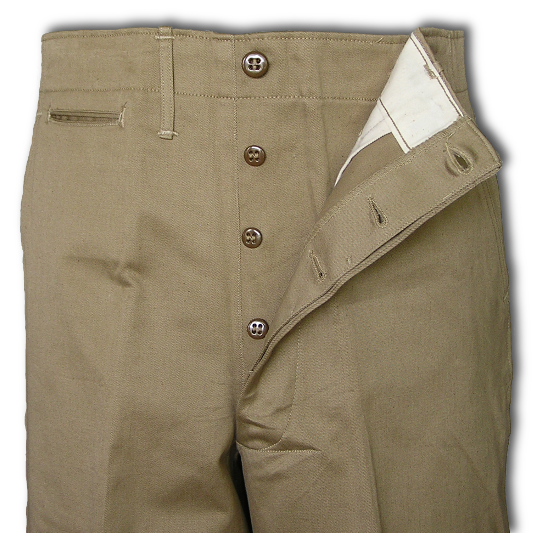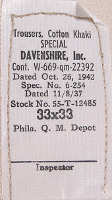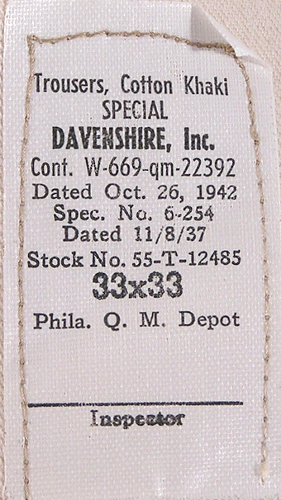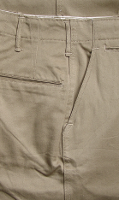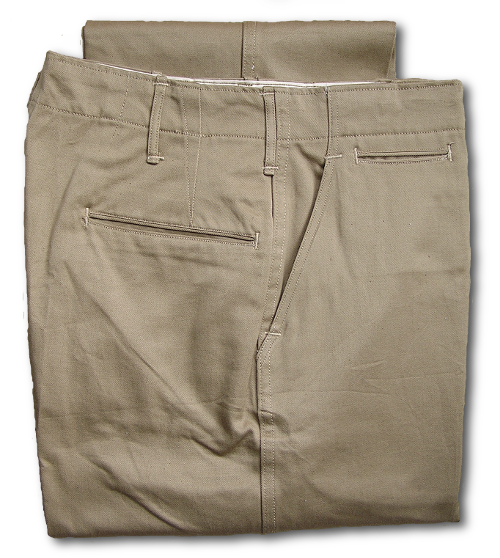U.S. Army Enlisted Men's Trousers
Special Cotton Khaki Trousers
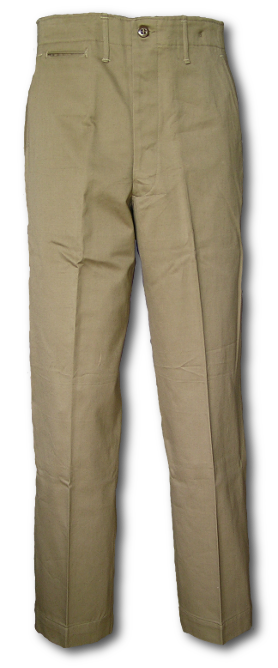

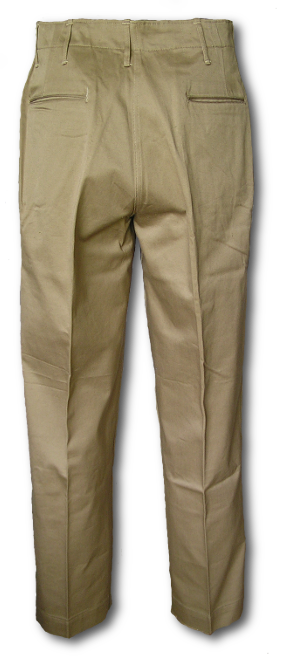
Specification 6-254 dated 8 November 1937
Stock No. 55-T-12400 - 55-T-12650
| ORGANIZATION, UNITS, SPECIALISTS, & STATUSES | ZONE OF INTERIOR |
|
||||||||||||||||||||||||||||||
|
||||||||||||||||||||||||||||||||
| Key Visual ID | Primary Materials | Fasteners | Color | Labeling |
| Double stitched seams and the presence of a gas flap across the front fly. | 8.2 oz cotton khaki.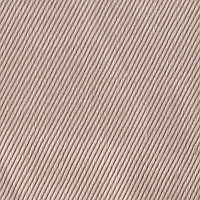 Cotton Khaki - A generic name given to brownish colored cotton twill weave material. The twill weave is easily identified by the distinctive diagonal ridges formed by the weft and warp yarns. Cotton Twill or Uniform Twill was used by the Army for a variety of light to medium weight items; from cotton khaki shirts and trousers to the outer shell of the winter combat jacket. | There were 6 buttons: 5 x front fly, 1 x gas flap located on the inside left waistband. | Khaki shade No. 1. | Sizing labels were either a small embroidered cloth tag or an ink stamp located on the inside right waistband. The Quartermaster label was located behind the front right pocket. |
| Treatments | Approx. Contract Run | Preceded By | Replaced By | Companion Garments |
| Cotton khaki trousers were produced with sanforized material to reduce shrinkage. | April 25, 1942 to November 11, 1942 (For special variant only). | Khaki Cotton Breeches, Spec. 6-65A dated 18 December 1936. Khaki Cotton Trousers, Spec. 6-254 dated 8 November 1937. | Special Khaki Cotton Trousers, Spec. PQD 339 dated 12 February 1943. | Khaki Cotton Shirt Cotton Field Hat Khaki Garrison Cap M-1937 Enlisted Man's Web Waist Belt. |
(hover for expanded view)
Approved in 1937, cotton khaki trousers were a result of an Army initiative to replace general issue breeches with a trouser design. In the pre-war years, the Khaki cotton uniform was the primary warm weather uniform for both garrison and field work. Prior to 1938, the khaki uniform consisted of breeches or the newly adopted trousers, a light-weight broad cloth shirt, service coat, and cap. In 1938 a new shirt was introduced to replace both the broad cloth shirt and service coat. This left a shirt, trouser, and cap combo that was designed for increased comfort in hot weather while offering adequate mosquito protection. The new trousers were worn tucked inside leggings when used in the field. Because of the field work requirement placed upon them, the trousers needed to be robust; and as a result were constructed using outward facing, double stitched seams. In 1941, as the ranks were swelling in anticipation of the coming war, it was realized that manufacturing capacity would not be able to keep up with the quantity of khaki trousers required to meet the mandatory allowance for new inductees. This resulted in a new trouser design being introduced in 1941 featuring inward facing seams held together by a single stitch line. The new stitch pattern allowed for increased trouser production by utilizing industry's much more abundant single stitch sewing machines. The new design carried a completely different specification number and was produced along with the traditional double stitch trousers throughout the war. Reports of bursting seams during field use were mostly attributed to the single stitch seams and led to the widening of the trouser seat on three different occasions during the war. By the summer of 1942 the two-piece herringbone twill fatigue uniform | In the spring of 1942 the Army began working protective gas flaps into existing clothing designs. The khaki trousers were no exception and during this time a gas flap was added across the fly. This was done to prevent poisonous agents from entering through the button closure area of the garment. When this change was made, the nomenclature was altered to show "Special Khaki Cotton Trousers" on the label instead of the previously used "Khaki Cotton Trousers". Along with the new name, an entirely new set of stock numbers were assigned to distinguish the special variant in the tables of equipment. In early 1943, after the seat had been widened for the third time and the gas flap added, the trousers were re-designated Special Khaki Cotton Trousers under the specification of PQD 339. Contracting of the pre-war specification 6-254 ended in the fall of 1942 in anticipation of the new design. Early war photographs show the khaki cotton uniform being used in the field as intended. Imagery is strong of early defenders facing the Japanese onslaught dressed in khaki uniforms and wearing the saucer style M1917-A1 helmet. But, by the time the United States gained the upper hand in the Pacific War, herringbone twill had replaced khakis in the combat field role. After this time photos show the Khaki uniform being worn in rear areas as a summer service uniform. Despite the huge quantities produced during the war, khaki trousers are noticeably less abundant today than their woolen counterparts. Their lower survivability is likely due to the trousers being worn out and discarded after the war. Post-war wear of khaki trousers is certainly understandable due to their less "military" appearance and comfortable, casual design when compared to the heavy, olive drab colored wool trousers. Khaki cotton trousers, having a humble beginning in the US Army, are now considered a classic design and live on strong in the civilian market today - a testament to the superior work of the U.S. Army Quartermaster Corps. |
